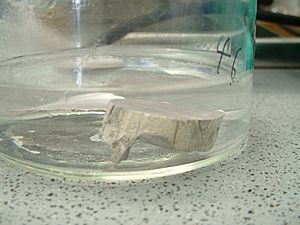Paraffin facts for kids
Paraffin is a common name for a group of chemical compounds called alkanes. These are a type of hydrocarbon, which means they are made up of only carbon and hydrogen atoms. You can think of them as long chains of these atoms.
Paraffin comes in different forms, depending on how many carbon atoms are in its chain.
Contents
What is Paraffin?
Paraffin refers to a family of chemical compounds. These compounds are known as alkanes. They are very stable and do not react easily with other chemicals. This makes them useful for many things.
Different Forms of Paraffin
Paraffin can be a gas, a liquid, or a solid, depending on the size of its molecules:
- Gas: The simplest paraffin is methane (CH4), which is a gas at room temperature. Methane is the main part of natural gas.
- Liquid: Heavier paraffin molecules, like octane (C8H18), are liquids at room temperature. You might know octane as a part of gasoline. Mineral oil is another liquid form of paraffin.
- Solid (Paraffin Wax): The heaviest paraffin molecules, with 20 to 40 carbon atoms, are solid. This solid form is what we call paraffin wax. It was first discovered by a scientist named Carl Reichenbach in 1830.
Where Does the Name Come From?
The word "paraffin" comes from two Latin words: parum, meaning "barely," and affinis, meaning "having affinity" or "reactivity." So, "paraffin" basically means "barely reactive."
This name fits perfectly because alkanes, including paraffin, are known for being very unreactive. They don't easily combine with other chemicals. This is because their molecules are "non-polar" and don't have special parts called "functional groups" that usually make chemicals reactive.
Paraffin Oil vs. Kerosene
Sometimes, the word "paraffin" can be a bit confusing because it means different things in different places.
- In countries like Ireland, Britain, and South Africa, "paraffin oil" or just "paraffin" is the name for a fuel.
- However, in most of the U.S., Australia, and New Zealand, this same fuel is called kerosene. Kerosene is often used in lamps or heaters.


